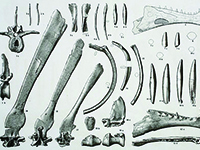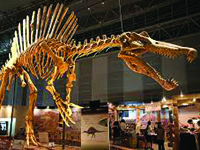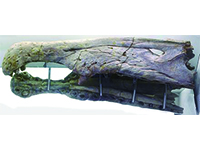
Naming
Two species of Spinosaurus have been named: Spinosaurus aegyptiacus (meaning "Egyptian spine lizard") and the disputed Spinosaurus maroccanus (meaning "Moroccan spine lizard").[20][21]
The first described remains of Spinosaurus were found and described in the early 20th century. In 1912, Richard Markgraf discovered a partial skeleton of a dinosaur in the Bahariya Formation of western Egypt. In 1915, German paleontologist Ernst Stromer published an article assigning the specimen to a new genus and species Spinosaurus aegyptiacus.[19][20]
Fragmentary additional remains from Bahariya, including vertebrae and hindlimb bones, were designated by Stromer as "Spinosaurus B" in 1934.[22] Stromer considered them different enough to belong to another species, and this has been borne out. With the advantage of more expeditions and material, it appears that they pertain either to Carcharodontosaurus[23] or to Sigilmassasaurus.[21]
S. maroccanus was originally described by Dale Russell in 1996 as a new species based on the length of its neck vertebrae.[21] Specifically, Russell claimed that the ratio of the length of the centrum (body of vertebra) to the height of the posterior articular facet was 1.1 in S. aegyptiacus and 1.5 in S. maroccanus.[21] Later authors have been split on this topic. Some authors note that the length of the vertebrae can vary from individual to individual, that the holotype specimen was destroyed and thus cannot be compared directly with the S. maroccanus specimen, and that it is unknown which cervical vertebrae the S. maroccanus specimens represent. Therefore, though some have retained the species as valid without much comment,[24][25][26] most researchers regard S. maroccanus as a nomen dubium[4][27][28] or as a junior synonym of S. aegyptiacus.[23]



